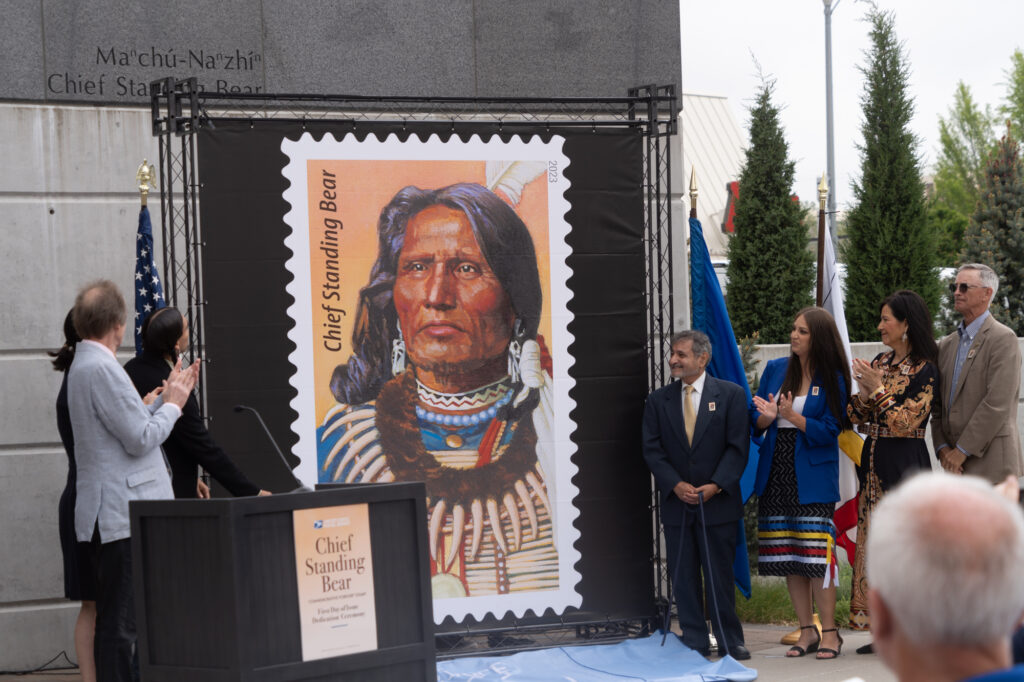
Zach Wendling / Nebraska Examiner
Nebraskans attend a U.S. Postal Service stamp ceremony Friday honoring Chief Standing Bear in Lincoln.
The story of Chief Standing Bear will spread across the nation with a U.S. Postal Service stamp issued Friday portraying the Ponca leader.
Nebraskans gathered outside Chief Standing Bear’s statue on Centennial Mall in downtown Lincoln, including USPS officials, Ponca Tribe leaders and descendants of the chief, to observe the nationwide honor.
Judi gaiashkibos, executive director of the Nebraska Commission of Indian Affairs, said it is amazing to see Chief Standing Bear’s story progress from when he was considered a non-person in 1879 to now being honored with the stamp.
“This story of an Indigenous rights hero is truly and deservedly an American story,” gaiashkibos said. “With this stamp, his legacy is further etched into our nation’s consciousness.”
‘Pillar for the Ponca Tribe’
Anton Hajjar, vice chairman of the USPS Board of Governors, said Chief Standing Bear’s legacy helped to bring the nation in line with the ideal that all men are created equal.
“It took our country far too long to recognize the humanity of many of its people, particularly the American Indians who lived on these lands for thousands of years,” he said.
USPS printed 18 million Chief Standing Bear stamps. Thomas Blackshear II illustrated the stamps based on an 1877 black-and-white photograph while art director Denny Noyes designed the stamp.
Candace Schmidt, chair of the Ponca Tribe of Nebraska, said Chief Standing Bear is a “pillar for the Ponca Tribe” and a pivotal civil rights leader.
The stamp, she said, helps illustrate Chief Standing Bear’s story of justice and triumph, which is also a story of the Ponca.
“It will serve as a symbol of pride and perseverance for all our members past, present and future,” Schmidt said.
Nearly 150-year legacy
Joe Starita, professor emeritus in the University of Nebraska-Lincoln’s College of Journalism and Mass Communications, explained that Chief Standing Bear wanted to uphold a promise to his son to return to his homeland.
Defying a government order, Starita said, Chief Standing Bear and nearly 30 others marched back to Nebraska in the bitter winter of 1879.
On May 12, 1879, 144 years ago to the date, an Omaha judge ruled in favor of Chief Standing Bear, extending civil rights for the first time to American Indians.
Starita said Chief Standing Bear is rightfully an American hero alongside George Washington, Ben Franklin, Abraham Lincoln, Rosa Parks and Martin Luther King Jr.
“Wouldn’t it be altogether fitting,” Starita said, “if we as a nation of Americans were to approach that table of American history heroes and we saw an empty chair with a brass plate above that said simply, ‘Reserved: Chief Standing Bear.’”
Steve Laravie Jr., a descendant of Chief Standing Bear, said his grandfather stood for many things, including compassion, unity, strength and vision.
Those who follow in his great-great-great-great-grandfather’s image, Laravie said, must remember and practice what he stood for.
“I’m not here to tell you how it is,” Laravie said. “I’m here to show you what is — the realities and truths of life.”
Schmidt said Chief Standing Bear exemplified the Ponca and native way “to think seven generations ahead because what we do today impacts tomorrow.”
“I challenge each and every one of us to be part of something bigger,” Schmidt said. “Let the stamp remind us to be the one to take a stand for justice and for doing what’s right.”








